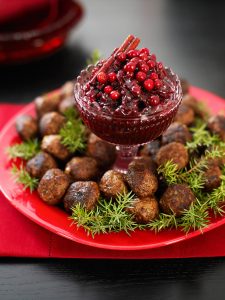
Our editor of the Alumni Network newsletter, Lundensaren, asked Håkan Jönsson, ethnologist at Lund University, what meatballs are doing in the Swedish Christmas buffet. Why are they there, and why are they so important to us?
What is the meatball doing in the Christmas buffet?
Brief answer: It is there because people like it. Slightly longer answer: Because the Swedish Christmas buffet combines two previous meal concepts – the traditional smörgåsbord which was developed into a special buffet to accompany schnapps, and the French hors d’oeuvre tradition of small dishes.
When did it end up there?
It is hard to say exactly, but after the Second World War, which makes it a recent arrival on Swedish Christmas tables.
When did we start calling the Christmas buffet simply “Christmas dinner”?
The Swedish Christmas buffet became a concept when it was served in restaurants, as a Christmas version of a traditional smörgåsbord. This happened after the First World War.
What was originally included in the Christmas buffet?
The original Christmas meal in Sweden was, above all, an opportunity to eat your fill of fresh meat, otherwise very seldom consumed. Food containing blood also has a short shelf-life, so it needed to be eaten soon after slaughter, whereas whole animal parts such as hams were salted and eaten at a later date. Pork ribs and black pudding are the dishes most reminiscent of Medieval Christmas food. Along with bread; baking special Christmas bread which looked good was an important feature of the festive season. Each member of the household would get their own Christmas pile of bread, one of very few occasions on which the various individuals in the household could decide for themselves when to eat.
And why does the meatball recur on the Easter buffet?
Because it is a popular element of the smörgåsbord and has acquired an aura of seeming at once traditional and familiar.
Pickled herring, or sill, which is now an important part of both Christmas and Easter food, has certainly long been on the menu. But since it was a cheap everyday staple, pickled herring was rather less important for Christmas and Easter meals, whereas now the opposite is true.
